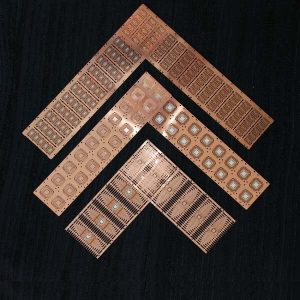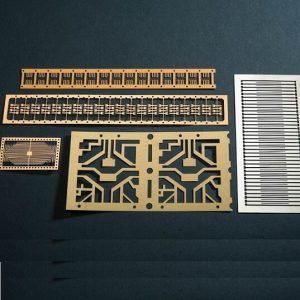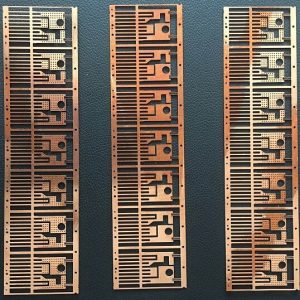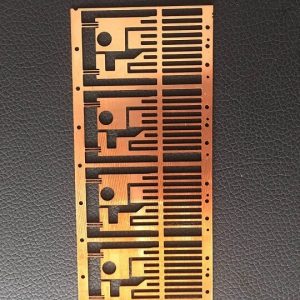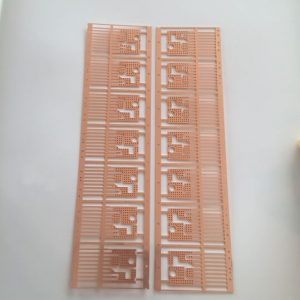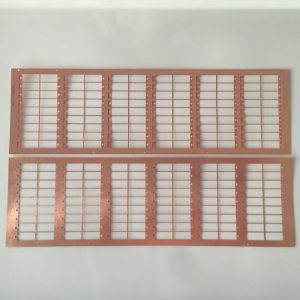Custom Lead Frame
What is the Purpose of a Lead Frame?
The primary purpose of a lead frame is to support and connect the semiconductor die within an integrated circuit package. Lead frames serve several key functions:
Mechanical Support: They provide a stable structure to which the semiconductor die is attached, ensuring it stays in place during manufacturing and use.
Electrical Connections: Lead frames create the pathways for electrical connections between the semiconductor die and external circuits. These connections are typically made through bonding wires or soldering.
Heat Dissipation: The metal structure of lead frames helps dissipate heat generated by the semiconductor die, contributing to the thermal management of the IC package.
Protection: Lead frames often serve as a base for encapsulation, which protects the semiconductor die from environmental factors like moisture and physical damage.
What are the Properties of Lead Frame Material?
Lead frame materials must possess specific properties to meet the demands of semiconductor packaging:
High Electrical Conductivity: This ensures efficient electrical connections and minimal resistance within the IC package.
Good Thermal Conductivity: Effective heat dissipation is crucial for maintaining the operational temperature of the semiconductor die.
Mechanical Strength and Durability: Lead frames must withstand the stresses of manufacturing processes like wire bonding, molding, and soldering.
Corrosion Resistance: The material must resist corrosion to ensure long-term reliability.
Dimensional Stability: Lead frames must maintain their shape and alignment throughout the manufacturing process and during the IC's lifecycle.
What is Lead Frame Paddle Size?
The paddle is the central portion of the lead frame where the semiconductor die is attached. Paddle size varies depending on the size of the semiconductor die and the specific requirements of the IC package. It plays a crucial role in:
Die Attachment: The paddle must be large enough to securely attach the semiconductor die.
Heat Dissipation: A larger paddle can improve heat dissipation by providing more surface area.
Mechanical Support: The paddle's size contributes to the overall stability of the IC package.
Paddle size is often defined by the package type and the specific design requirements of the IC.
What are Lead Frames Made Of?
Lead frames are typically made of metal alloys chosen for their electrical conductivity, thermal conductivity, mechanical strength, and corrosion resistance. The most common materials used in lead frames are:
Copper Alloys: Copper is a preferred material due to its high electrical and thermal conductivity. Copper-based lead frames often contain additional elements like iron, nickel, or cobalt to improve mechanical strength and dimensional stability.
Alloy 42: This is an iron-nickel alloy that has a low coefficient of thermal expansion, making it suitable for applications where dimensional stability is crucial, especially when the lead frame is attached to glass or ceramic components.
Kovar: This is another iron-nickel-cobalt alloy with similar thermal expansion properties to glass and ceramic, used for hermetically sealed packages.
These materials are often coated or plated with additional metals to improve solderability, enhance corrosion resistance, and reduce oxidation. Common plating materials include:
Tin (Sn): A popular choice for plating due to its good solderability and corrosion resistance.
Silver (Ag): Used to improve electrical conductivity and enhance solderability, especially in high-frequency applications.
Gold (Au): Provides excellent corrosion resistance and solderability but is typically used in high-end applications due to its cost.
The choice of lead frame material and plating depends on the specific requirements of the semiconductor device, such as thermal management, electrical characteristics, and environmental conditions.
How do You Manufacture a Lead Frame?
Lead frame manufacturing involves several key processes, each contributing to the final structure of the lead frame:
Stamping: In this process, a large metal sheet is stamped to create the desired lead frame pattern. Stamping is a cost-effective method for high-volume production.
Etching: Chemical etching uses acid or other chemicals to remove material and create intricate lead frame patterns. This method is ideal for complex designs and smaller production runs.
Plating: After stamping or etching, lead frames are often plated with metals like tin, silver, or gold. Plating improves corrosion resistance and enhances solderability.
Assembly: The final step involves assembling the lead frame with the semiconductor die and other components, followed by encapsulation and packaging.
Lead frame manufacturing is a critical part of the semiconductor industry, with ongoing advancements in materials and processes to meet the evolving demands of modern electronics.
In summary, lead frames play a crucial role in semiconductor packaging, providing electrical connections, mechanical support, and heat dissipation. Their design and manufacturing require careful consideration of material properties and production processes to ensure the reliability and performance of integrated circuits.
Lead Frame Manufacturer: Partner for Custom Solutions
If you're seeking custom lead frames, look no further than TMN's, a leading manufacturer specializing in photochemical etching for lead frame production. We offer comprehensive, integrated solutions for all your lead frame needs, from design and prototyping to full-scale production.
With our advanced etching technology and extensive experience in the industry, we can create intricate lead frame patterns with high precision and accuracy. Our state-of-the-art equipment and skilled team ensure that every lead frame meets your specifications, whether for complex designs or high-volume production.
Learn more about TMN’s photo etching lead frame customization capabilities>>>

